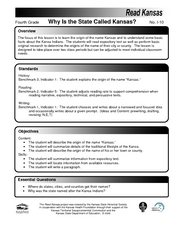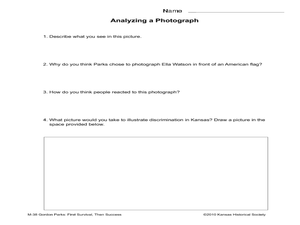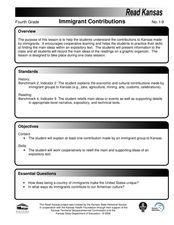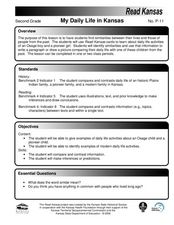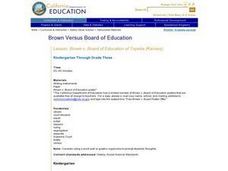Curated OER
Why Is The State Called Kansas?
Fourth graders research how cities are named. In this states names lesson, 4th graders discuss whom the state of Kansas was named after, work with a partner to write down what they've learned about Kansas, research the origins of...
Curated OER
Kansas Prairie Homes
Students read about settlers in Kansas and the adaptations they made in order to build different kinds of houses. In this Kansas settlers lesson plan, students participate in choral reading and retell information they learn.
Curated OER
Progressive Movement in Kansas
Seventh graders examine the Progressive Movement in Kansas. In this Progressive Era activity, 7th graders study various facts about this era in Kansas. Students create a presentation on a law that was passed during this time.
Curated OER
Gordon Parks:First Survival, Then Success
Have your class examine the work of Gordan Parks. They determine how Park's childhood in Kansas inspired his artwork as they analyze his writings and photographs. Students complete the provided worksheets as they compare, contrast, and...
Curated OER
The Role of the Media
Students participate in class discussion to investigate how media affects the ideas of Americans (specifically in politics) and then research events in political history to analyze how the media may have influenced the government's...
Curated OER
Kansas City History
Students conduct research and present a part of Kansas City history to the class. They develop questions and ideas to initiate and refine research. They use technological tools and other resources to locate, select and organize information.
Curated OER
American Indian Homes in Kansas
First graders explore culture by researching U.S. history. In this American Indian lesson, 1st graders discuss the geography of Kansas and the different Native American tribes that inhabited the state and the types of homes they lived...
Curated OER
Immigrant Contributions
Students read a passage about immigrants making contributions to the state of Kansas and write the main ideas and details of what they read. For this immigrant contributions lesson plan, students fill out a graphic organizer of immigrant...
Curated OER
From Jim Crow To Linda Brown: A Retrospective of the African-American Experience from 1897 to 1953
Learners examine African American issue between the years 1897 and 1953. In this African American history lesson, students research the social, economic, and political conditions of African Americans during the aforementioned time span...
Curated OER
Nomadic and Sedentary Tribes in Kansas
Seventh graders compare and contrast sedentary and nomadic tribe life. In this Native American culture lesson, 7th graders research primary documents about the Osage and Kiowa tribes. Students create a series of illustrations to be...
NET Foundation for Television
1850-1874 Native Americans and Settlers
Did Western settlers receiving free land from the Homestead Act realize it wasn't really free at all? Scholars investigate the impact Western expansion had on Native American culture in the mid-1800s. They use documents, timelines, and...
NET Foundation for Television
1850-1874 Homestead Act Signed: Who were the Settlers?
Life in the great, wide-open spaces of the West! Scholars analyze the reasons behind the vast movement to the Great Plains after the passing of the Kansas-Nebraska Act and the Homestead Act. Using photographic, document, map, video, and...
NET Foundation for Television
1850-1874 Railroads and Settlement
Have you ever wondered how your town was placed where it is? Scholars research the impact the advancement of the railroad due to the passage of the Kansas-Nebraska Act had on the formation of civilization in the Great Plains. Map...
NET Foundation for Television
1850-1874 Notable Nebraskan: J. Sterling Morton
What are the characteristics of an outstanding citizen? Nebraskan J. Sterling Morton contributed to the formation of societal and family values in his state. Learners gather information on Morton's life accomplishments from primary...
Curated OER
My Daily Life in Kansas
Second graders use 'Read Kansas' cards to learn about the daily life activities of an Osage boy and a pioneer girl. In this similarities and differences lesson, 2nd graders write a paragraph and draw a picture comparing...
Curated OER
The Hmong Migration
Seventh graders investigate possible reasons the Hmong settled in Kansas. In this United States History lesson, 7th graders read an article that discusses the history of the Hmong people, then have a class discussion on the article...
Curated OER
Piecing Together the Story of Glenn Cunningham: A Kansas Champion
Learners use primary and secondary sources to conduct research about Glenn Cunningham. In this Glenn Cunningham lesson plan, students tell why he was a hero, and tell facts from what they learned.
Curated OER
Arkansas Civil War Bandits and Outlaws
Young historians study civilian Arkansas during the Civil War. They look at the many challenges they faced to keep their homes in order while the men were at war. Learners hear stories of bands of outlaws who ravaged the state during...
Curated OER
Hit the Trail
Students read about the history of cattle trails and complete language arts, math, social studies, and more activities about barbed wire. For this barbed wire lesson plan, students read poetry, research changes over time, draw cattle...
Curated OER
Understanding Clues from the Past: School Days
Third graders read primary and secondary sources as the study about schools in the early years of Kansas. For this primary and secondary source lesson, 3rd graders examine how historians use primary source documents to tell about the...
Curated OER
The Tale of Genji
Did you know that the world's first novel was written by a woman? Murasaki Shikibu's The Tale of Genji, was published in 1021. Class members research Eastern and Western cultures in the 10th and 11th centuries, view modern adaptations of...
Curated OER
From Jim Crow to Linda Brown: A Retrospective of the African-American Experience from 1897 to 1953.
Students research the American Memory collection to explore the African-American experience from 1897 to 1953.
Curated OER
Brown v. Board of Education of Topeka (Kansas) (Grades K-3)
Students examine the Brown v. Board of Education case in Topeka, Kansas. They re-enact the courtroom and discuss how school would be different today if this case never existed. They discuss how public education has been affected by this...
Curated OER
Cooking Kansas City
Students investigate the history of Kansas City and then create recipes from the area, including Kansas City Barbecue Sauce, and Kansas City Corn.
